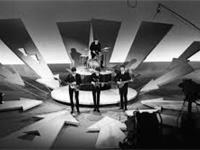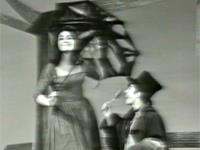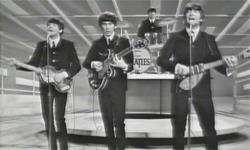Fifty years ago – on Feb. 7, 1964 – The Beatles touched down at JFK airport, launching the British Invasion in America. Two days later, they stormed The Ed Sullivan Show, and changed the world…
It’s tricky, half a century later, to recapture the full context in which Beatlemania took hold in America – and how quickly. But it’s fun to try. I’ll be hosting a special Beatle-related NPR Fresh Air with Terry Gross show on Friday – and in my TV History & Appreciation of the ’60s and ’70s classes at Rowan University in New Jersey, I’ve shuffled the usual order of things to present my British invasion segments this week and next.
 The centerpiece, of course, was, and remains, CBS’s The Ed Sullivan Show. Beatles manager Brian Epstein negotiated for “the boys” – John Lennon, Paul McCartney, George Harrison and Ringo Starr – to appear on three consecutive Sullivan shows in February 1964, for a $10,000 fee.
The centerpiece, of course, was, and remains, CBS’s The Ed Sullivan Show. Beatles manager Brian Epstein negotiated for “the boys” – John Lennon, Paul McCartney, George Harrison and Ringo Starr – to appear on three consecutive Sullivan shows in February 1964, for a $10,000 fee.
It was a sum Sullivan always boasted about, after the fact, as an absolute steal. But Epstein was savvy enough to care less about the upfront advance than the residual, invaluable momentum such exposure could generate. And he was right: 73 million Americans watched that Feb. 9, 1964 show, some 60 percent of all TV homes.
I was one of them. Nine years old. And I still remember it.
CBS is commemorating the occasion by presenting a network special at the exact hour, 50 years later, in which The Beatles made their first live American TV appearance. Sunday night at 8 ET, CBS will televise The Night That Changed America: A Grammy Salute to the Beatles. Musical portions, filmed after the Grammys two weeks ago, feature not only surviving Beatles Paul and Ringo, but also Stevie Wonder, Katy Perry, Eurythmics, Dave Grohl and Alicia Keys, all performing Beatles music.
And in a segment taped Tuesday at what is now called The Ed Sullivan Theatre, in the same studio where The Beatles played The Ed Sullivan Show 50 years ago, David Letterman interviews Paul and Ringo. There’s no studio audience for that segment – which makes it the polar opposite of half a century ago, when screaming teens and preteen girls turned from grasshoppers to locusts in front of a nation’s spellbound eyes.
That first Ed Sullivan Show, seen in its entirety, is a hoot. (And you can see it in its entirety, by ordering The Four Complete Ed Sullivan Shows Featuring the Beatles.) I show portions of it in class – not only the segments featuring The Beatles, but the rest of the hour, which puts the freshness of the Fab Four in true perspective.
After a wooden intro by Sullivan, The Beatles sing three songs in rapid succession. The sound engineers aren’t impressive (John’s mic is off much of the time, just as Paul’s would be for their second appearance), but the group itself certainly is. “All My Loving” starts things off. “Till There Was You,” a ballad from Broadway’s The Music Man, slows things down and appeases the adult viewers. And the high-energy “She Loves You,” with its hair-shaking “wooooo” chorus, finishes the first of the show’s two mini-sets with a flourish.
 Then, as though an instant commentary from the powers that be, comes a commercial for Anacin – a pounding, repetitive cry of “pain,” literally. And after that comes one of the most painful anticlimaxes in TV history. Poor Fred Kaps, a Dutch magician, performed card tricks in a pre-recorded segment that, to the hyperkinetic Ed Sullivan studio audience, must have seemed like sheer torture. Other acts to come in that hour, like brassy British dance hall diva Tessie O’Shea and comics Mitzi McCall and Charlie Brill, and acrobats Wells & the Four Fays, also seemed more like punishment than entertainment.
Then, as though an instant commentary from the powers that be, comes a commercial for Anacin – a pounding, repetitive cry of “pain,” literally. And after that comes one of the most painful anticlimaxes in TV history. Poor Fred Kaps, a Dutch magician, performed card tricks in a pre-recorded segment that, to the hyperkinetic Ed Sullivan studio audience, must have seemed like sheer torture. Other acts to come in that hour, like brassy British dance hall diva Tessie O’Shea and comics Mitzi McCall and Charlie Brill, and acrobats Wells & the Four Fays, also seemed more like punishment than entertainment.
But other acts were noteworthy, if for reasons more historical than hysterical. Impressionist Frank Gorshin, still a few years away from playing The Riddler on ABC’s Batman, started his act by posing a prescient hypothetical: What if Hollywood celebrities, instead of endorsing political candidates during election years, decided to cash in on their popularity by running for office themselves? Presto: Coming very soon, first as California governor and then as U.S. President, Ronald Reagan.

And in a segment presenting a couple of numbers from the current Broadway musical Oliver!, the first song opened with Georgia Brown being serenaded by a short, young British singer, adopting a strong Cockney accent. His name? Davy Jones. Within two years, he would answer an ad in the Hollywood trades, and audition for and be chosen as one of the stars of a new NBC series called The Monkees, designed specifically to imitate, and cash in on, the popularity of The Beatles. Jones has been interviewed about watching from the wings as The Beatles played that initial Ed Sullivan Show – and admitted that he watched them with a mixture of envy and inspiration. That’s what he wanted to do, he thought – and before too long, as the heartthrob singer of The Monkees, he got closer than most musicians to that very dream.
 The Beatles closed that first Sullivan show with “I Want to Hold Your Hand,” which had just become a #1 hit on the United States chart eight days before. That was the only song they played on all three Sullivan Shows that February – and on the third one, the sound guys finally got it right.
The Beatles closed that first Sullivan show with “I Want to Hold Your Hand,” which had just become a #1 hit on the United States chart eight days before. That was the only song they played on all three Sullivan Shows that February – and on the third one, the sound guys finally got it right.
But by then, it barely mattered. The Beatles had invaded America, and America had surrendered immediately. Our country, our culture, and especially our music would never be the same.